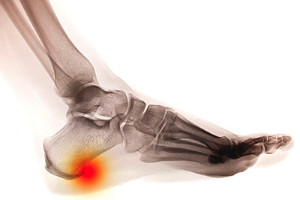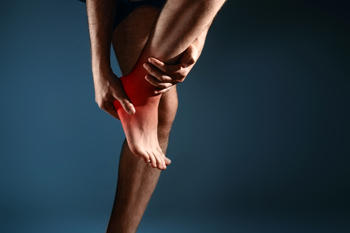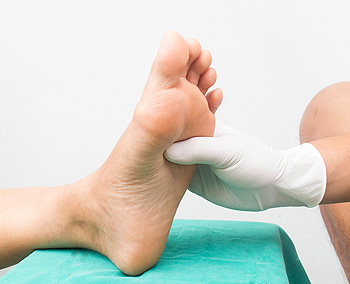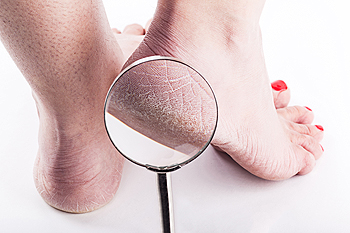Items filtered by date: August 2022
Causes and Treatment of Heel Spurs

A heel spur is caused when calcium builds up on the heel bone. It can be a plantar heel spur, which grows on the bottom of the heel, or a posterior heel spur, which grows on the back of the heel. A great many people have heel spurs and won’t know it until the spurs show up on an X-ray. Others with heel spurs can experience a great deal of pain, which can be acute, intermittent, or chronic. The precise cause of heel spurs has been debated by scientists, but what is clear is that more than 80 percent of people who have them are overweight. Older people also are more likely to develop heel spurs, as are post-menopausal women. Possible causes include arthritis, plantar fasciitis, excessive running or jogging, and shoes without adequate cushioning in the heel. The two main ways to treat bone spurs are resting and icing the foot and wearing orthotic shoe inserts. If the pain caused by heel spurs continues or worsens, it is a good idea to visit a podiatrist who may suggest further treatment options, such as corticosteroid injections and being fitted for custom orthotics.
Heel spurs can be incredibly painful and sometimes may make you unable to participate in physical activities. To get medical care for your heel spurs, contact the foot specialists from Table Mountain Foot and Ankle. Our doctors will do everything possible to treat your condition.
Heels Spurs
Heel spurs are formed by calcium deposits on the back of the foot where the heel is. This can also be caused by small fragments of bone breaking off one section of the foot, attaching onto the back of the foot. Heel spurs can also be bone growth on the back of the foot and may grow in the direction of the arch of the foot.
Older individuals usually suffer from heel spurs and pain sometimes intensifies with age. One of the main condition's spurs are related to is plantar fasciitis.
Pain
The pain associated with spurs is often because of weight placed on the feet. When someone is walking, their entire weight is concentrated on the feet. Bone spurs then have the tendency to affect other bones and tissues around the foot. As the pain continues, the feet will become tender and sensitive over time.
Treatments
There are many ways to treat heel spurs. If one is suffering from heel spurs in conjunction with pain, there are several methods for healing. Medication, surgery, and herbal care are some options.
If you have any questions feel free to contact our office located in Wheat Ridge, CO . We offer the latest in diagnostic and treatment technology to meet your needs.
It's Time for Beautiful Feet
Several Reasons That Foot Pain May Develop

The foot is a complex structure. There are several areas where foot pain can develop, including the toes, heels, soles, and arches. Pain can negatively affect the overall body and can cause difficulty in completing daily activities. A common cause of foot pain can be from wearing shoes that do not fit correctly, frequently wearing high heels, or increasing speed and intensity too quickly while running. There may be existing medical conditions that can lead to foot pain. These include arthritis, foot ulcers, or clogged arteries in the legs and feet. Many pregnant women may have foot pain from the added weight of the fetus and thickened blood during pregnancy. Having an ingrown toenail is a common source of foot pain, in addition to having a bunion, hammertoe, or athlete’s foot. Mild relief may come from elevating the feet as often as possible, and using foot pads on the affected area may temporarily feel good. If you have any type of foot pain, it is strongly advised that you are under the care of a podiatrist who can properly diagnose and treat your condition.
Foot Pain
Foot pain can be extremely painful and debilitating. If you have a foot pain, consult with the foot specialists from Table Mountain Foot and Ankle. Our doctors will assess your condition and provide you with quality foot and ankle treatment.
Causes
Foot pain is a very broad condition that could be caused by one or more ailments. The most common include:
- Bunions
- Hammertoes
- Plantar Fasciitis
- Bone Spurs
- Corns
- Tarsal Tunnel Syndrome
- Ingrown Toenails
- Arthritis (such as Gout, Rheumatoid, and Osteoarthritis)
- Flat Feet
- Injury (from stress fractures, broken toe, foot, ankle, Achilles tendon ruptures, and sprains)
- And more
Diagnosis
To figure out the cause of foot pain, podiatrists utilize several different methods. This can range from simple visual inspections and sensation tests to X-rays and MRI scans. Prior medical history, family medical history, and any recent physical traumatic events will all be taken into consideration for a proper diagnosis.
Treatment
Treatment depends upon the cause of the foot pain. Whether it is resting, staying off the foot, or having surgery; podiatrists have a number of treatment options available for foot pain.
If you have any questions, please feel free to contact our office located in Wheat Ridge, CO . We offer the newest diagnostic and treatment technologies for all your foot care needs.
Runners and Blisters

People who enjoy running are often familiar with blisters. Patients who get them often can generally feel when they are developing blisters and may wear running socks to prevent them. Blisters come from wearing shoes and socks that can cause excess friction and develop as the body’s natural defense to heal damaged skin. It is defined as a small area that resembles a bubble that is filled with fluid, and it immediately forms over the damaged skin. When new skin has formed, the blister will gradually drain as it is no longer needed. There may be existing medical reasons why people get blisters including eczema and psoriasis, in addition to having overly dry skin. A bunion may be the cause of blisters forming on the feet and this often happens from wearing shoes that are too tight. It is beneficial for people who run to gradually build up the skin on their feet as this may lead to getting blisters less often. If you frequently get blisters on your feet and would like to know more information about treatment and prevention, please confer with a podiatrist.
Blisters are prone to making everyday activities extremely uncomfortable. If your feet are hurting, contact the foot specialists of Table Mountain Foot and Ankle. Our doctors can provide the care you need to keep you pain-free and on your feet.
Foot Blisters
Foot blisters develop as a result of constantly wearing tight or ill-fitting footwear. This happens due to the constant rubbing from the shoe, which can often lead to pain.
What Are Foot Blisters?
A foot blister is a small fluid-filled pocket that forms on the upper-most layer of the skin. Blisters are filled with clear fluid and can lead to blood drainage or pus if the area becomes infected.
How Do Blisters Form?
Blisters on the feet are often the result of constant friction of skin and material, usually by shoe rubbing. Walking in sandals, boots, or shoes that don’t fit properly for long periods of time can result in a blister. Having consistent foot moisture and humidity can easily lead to blister formation.
Prevention & Treatment
It is important to properly care for the affected area in order to prevent infection and ease the pain. Do not lance the blister and use a Band-Aid to provide pain relief. Also, be sure to keep your feet dry and wear proper fitting shoes. If you see blood or pus in a blister, seek assistance from a podiatrist.
If you have any questions, please feel free to contact our office located in Wheat Ridge, CO . We offer the newest diagnostic and treatment technologies for all your foot care needs.
Ways Diabetes Affects Your Feet

Diabetes is a systemic disease that results from a blood sugar-insulin imbalance. As this condition progresses, it can also affect other body parts, particularly the feet. A condition known as diabetic neuropathy may develop, which in turn can cause other severe health problems. Diabetic neuropathy is thought to affect about 50 percent of diabetics. Excess blood sugar can damage the blood vessels that nourish the nerves in the feet and lower legs. This can cause tingling, numbness, or burning pain that may start in the toes and spread upward. The ability to feel differences in temperature or pain in the feet can become dangerous. Muscle weakness and dizziness also may put the diabetic at further risk for falls or other injuries. Foot ulcers may develop if cuts or sores won’t heal or become infected. Because these changes may be gradual, they can easily be ignored as just a normal part of aging. However, there are a number of treatments that can reduce the effects of diabetic neuropathy. If you have diabetes, it is suggested that you consult with a podiatrist as soon as possible for guidance and treatment options.
Diabetic foot care is important in preventing foot ailments such as ulcers. If you are suffering from diabetes or have any other concerns about your feet, contact the foot specialists from Table Mountain Foot and Ankle. Our doctors can provide the care you need to keep you pain-free and on your feet.
Diabetic Foot Care
Diabetes affects millions of people every year. The condition can damage blood vessels in many parts of the body, especially the feet. Because of this, taking care of your feet is essential if you have diabetes, and having a podiatrist help monitor your foot health is highly recommended.
The Importance of Caring for Your Feet
- Routinely inspect your feet for bruises or sores.
- Wear socks that fit your feet comfortably.
- Wear comfortable shoes that provide adequate support.
Patients with diabetes should have their doctor monitor their blood levels, as blood sugar levels play such a huge role in diabetic care. Monitoring these levels on a regular basis is highly advised.
It is always best to inform your healthcare professional of any concerns you may have regarding your feet, especially for diabetic patients. Early treatment and routine foot examinations are keys to maintaining proper health, especially because severe complications can arise if proper treatment is not applied.
If you have any questions please feel free to contact our office located in Wheat Ridge, CO . We offer the newest diagnostic and treatment technologies for all your foot and ankle needs.
Treatment for Dry or Cracked Heels

When dry skin, known as xerosis, occurs on the heels, it can be caused by a number of factors, such as wearing open-backed shoes, being overweight, or the constant rubbing of the heel within a shoe. Cracked skin also can be a sign of diabetes or neuropathy. Further causes include taking extra hot showers, using harsh soaps, cold weather, and standing for long periods. If dealt with early, dry or cracked heels can be lessened or even eliminated. Ignored, they may cause serious illness. In severe cases, cracked heels may become infected, causing cellulitis. A few easy treatments include soaking the feet in warm water, drying them completely, and applying moisturizer. It also may be good to use a pumice or nail file to gently scrub away the dead skin. Protect your feet from extreme heat, such as walking barefoot on hot sand or pavement. However, if your heels are severely cracked and painful, it is a good idea to make an appointment with a podiatrist for an exam and treatment as soon as possible.
Cracked heels are unsightly and can cause further damage to your shoes and feet. If you have any concerns, contact the foot specialists from Table Mountain Foot and Ankle. Our doctors can provide the care you need to keep you pain-free and on your feet.
Cracked Heels
Cracked heels appear unappealing and can make it harder for you walk around in sandals. Aside from looking unpleasant, cracked heels can also tear stockings, socks, and wear out your shoes. There are several methods to help restore a cracked heel and prevent further damage.
How Do You Get Them?
Dry skin is the number one culprit in creating cracked heels. Many athletes, walkers, joggers, and even swimmers suffer from cracked heels. Age and skin oil production play a role to getting cracked heels as well.
Promote Healing
Over the counter medicines can help, especially for those that need instant relief or who suffer from chronic dry feet.
Wear Socks – Wearing socks with medicated creams helps lock in moisture.
Moisturizers – Applying both day and night will help alleviate dryness which causes cracking.
Pumice Stones – These exfoliate and remove dead skin, which allows for smoother moisturizer application and better absorption into the skin.
Change in Diet
Eating healthy with a well-balanced diet will give the skin a fresh and radiant look. Your body responds to the kinds of food you ingest. Omega-3 fatty acids and zinc supplements can also revitalize skin tissue.
Most importantly, seek professional help if unsure how to proceed in treating cracked heels. A podiatrist will help you with any questions or information needed.
If you have any questions, please feel free to contact our office located in Wheat Ridge, CO . We offer the newest diagnostic and treatment technologies for all your foot care needs.

